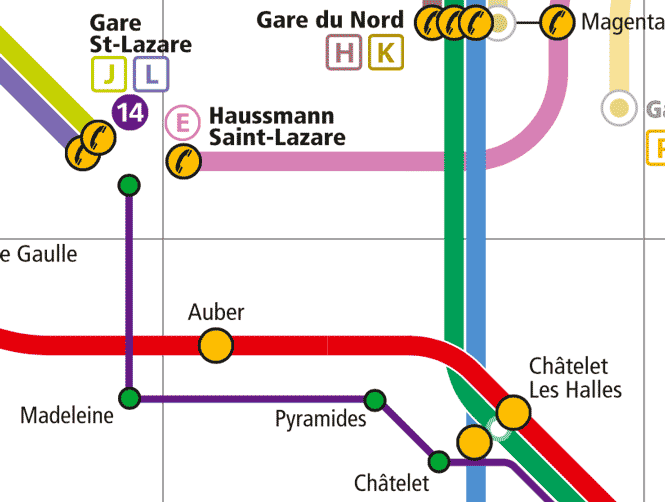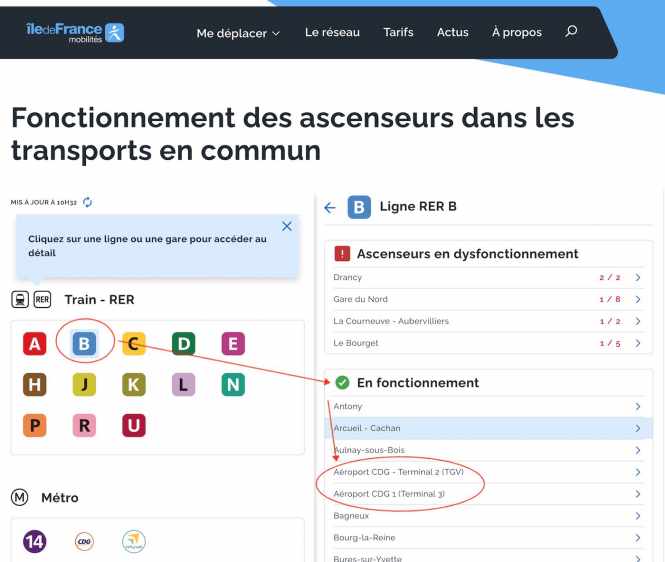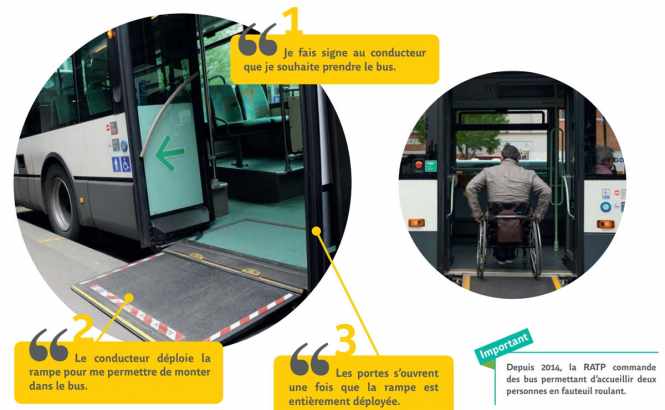For a list of completely wheelchair accessible stations, look for the green dots/circles for stations on this map of wheelchair accessible Metro, RER and Tram stations in Paris (2MB PDF):
Stations on the above map with a green circle/dot are fully wheelchair accessible roll-on / roll-off without any assistance. Stations with yellow dots are wheelchair accessible with help from train drivers and station staff, available upon request / on-demand. Stations with a yellow circled telephone are wheelchair accessible only by prior reservation to the station staff by telephone at +33 970 824 142 or by email at: [email protected].
There are roughly 50 Metro/RER stations within central Paris that have elevators and accessibility for wheelchairs. (See a list of wheelchair accessible Paris RER / Metro stations [by elevator].)
Although the yellow dot Metro / RER stations themselves will be accessible (on the above map), very few Metro / RER lines have complete roll-on accessibility for the train itself. Metro Line 14 and all Paris Tram lines have complete roll-on / roll-off access for wheelchairs right onto the trains. All Metro 14 station stops are wheelchair accessible by elevator. All Paris Tram stops are wheelchair accessible by ramp. For RER trains the train conductor and/or station staff will help wheelchairs roll onto the first passenger train car using a portable ramp they will place between the platform gap and the train car for boarding the train and disembarking.
Wheelchair Access to Platform
To find out about wheelchair accessibility from street level to the train platforms using elevators, we can use this web page showing current elevator operation issues.
Below is a screenshot of the Paris train/TGV/RER/Metro station elevator status web page. Highlighted are the button clicks to show the elevator status at CDG Airport. Start by clicking the RER B line, then look for terminals Aeroport CDG Terminal 2 or Aeroport CDG 1. Aeroport CDG 1 serves both CDG Terminal 1 and Terminal 3 (only RER trains to Paris), Aeroport CDG – Terminal 2 is for CDG Terminal 2, both TGV trains to other cities & RER trains to Paris. Clicking on the airport terminal on right will show further details on each elevator at the chosen terminal.
When choosing a Metro, RER, or suburban train (Transilien) from the left side of this page, the right side will list elevator status for all stations along that train line, both out-of-service and in-service. The upper section lists stations whereone or more elevators are not currently in service (“ascenseurs en dysfonctionnement”). The section below that shows stations along the chosen RER/Train/Metro line where all elevators are functioning normally (“en fonctionnement“).
Any Metro line not listed on the left side of the elevators status page has no elevator access to the train platform and is therefore not wheelchair accessible. (As of 2023, the only wheelchair elevator accessible Metro line in Paris is Metro line 14.)
Any station shown on the right side of the elevators status page with all elevators out of service (ascenseurs en dysfonctionnement), shown in red numbers such as 3/3, is currently not wheelchair accessible, since all elevators are non-functioning.
RER Train Wheelchair Accessibility Guide
Paris RER Train Wheelchair Accessibility Guide – This wheelchair accessibility guide (in French) is for Paris RER trains (such as RER A / RER B). This Paris RER train wheelchair guide explains in photos how a wheelchair user can make trips on Paris RER trains from start to finish, including finding elevator-equipped stations, buying tickets, passing through fare gates, arriving at train platforms and boarding and leaving trains with assistance from the train conductor.
The other Metro lines that have accessibility up until the train itself include Metro Lines 1, 2, and 13. The RER B train, popular for its CDG Airport to Paris route, has accessibility only with assistance from train conductors / drivers due to the platform gap when boarding and alighting.
On the left hand side of the map, half-way down, is an index of Metro, RER, Tram and Train stations (“Index des gares et stations accessibles”). Below is an excerpt example from the stations index:

Listed on the wheelchair accessibility map index are:
- station names (such as Auber)
- type of train served. For Auber, the red circle A means RER A train. Train types include:
- Metro (subway) with a circle M symbol
- RER (suburban train / express subway) with a circle A/B/C/D/E
- Tram with a circle T symbol followed by circle number
- Transilien Train (intercity train) with a square letter symbol
- whether wheelchairs can roll-on/roll-off unassisted onto the train cars (green circle/dot)
- wheelchairs require on-demand assistance by train driver / station staff (yellow circle/dot)
- wheelchairs require prior reservation for assistance by train driver / station staff (yellow circle/dot with telephone symbol) by telephone at +33 970 824 142 or by email at: [email protected]
All other trains / stations will require help from staff or other passengers to lift chairs onto train cars. In general Parisien travelers are very willing to help those with reduced mobility ascend and descend trains so don’t hesitate to ask or make gestures to such effect.
Nearly all Buses in Paris are now wheelchair accessible. Paris buses are able to kneel and are equipped with an automated folding wheelchair ramp. The bus wheelchair ramp will extend from the rear bus doors to the sidewalk allowing wheelchairs to roll-on and roll-off without outside assistance. There are ticket and pass validation machines at the rear bus door entrance to allow validation of fares. A wheelchair parking spot clear of any seats is reserved aboard the bus near the rear doors.
Intercity trains such as TGV, Ter, and Transilien at the major Paris train stations (“gares” such as Gare de Lyon, Gare du Nord) most often have a step or two at car doors in order to board the trains, thus wheelchair travelers will require assistance for boarding.
Paris Bus Wheelchair Accessibility Guide
The Paris transit authority has also created a Paris Bus Wheelchair accessibility guide (in French) to help visualize how to take buses in Paris while using a wheelchair.
Reduced Mobility
For travelers with reduced mobility, but not confined to a wheelchair, certain stations feature long connections requiring a good deal of walking or stair climbing which may be best to avoid. Unfortunately it’s not possible to simply classify stations as mobility friendly or not since different connections to different lines within the same station will require different amounts of walking and stairs. Some connections may require only seconds of walking while others will require ten or more minutes.
Nearly all stations feature escalators, but there are often small sets of stairs which are present throughout the Metro for traversing over or under connecting lines.
One way to get an idea of walking distance when making connections is by using the a Metro Route Planner and observing the walking time provided in the results (when transferring from one line to another within a station). From the time required to walk from one train platform to a connecting one you can estimate the distance and the level of mobility require to make the connection.
More information links:
https://www.ratp.fr/accessibilite/accessibilite-des-reseaux
What Next?
- Search:
- Ask a question




